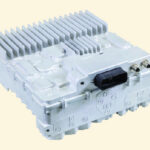2025-01-07 オークリッジ国立研究所
 Simulations performed on ORNL’s Summit supercomputer may point to a solution for the problem of runaway electrons inside a fusion reactor’s tokamak. The study suggests the Alfvén wave, left, a ripple-like fluctuation of the magnetic field within the reactor’s plasma, could be used to disperse the electrons, right. Credit: Chang Liu, Princeton Plasma Physics Laboratory
Simulations performed on ORNL’s Summit supercomputer may point to a solution for the problem of runaway electrons inside a fusion reactor’s tokamak. The study suggests the Alfvén wave, left, a ripple-like fluctuation of the magnetic field within the reactor’s plasma, could be used to disperse the electrons, right. Credit: Chang Liu, Princeton Plasma Physics Laboratory
<関連情報>
- https://www.ornl.gov/news/reining-runaway-electrons-summit-study-could-help-solve-fusion-dilemma
- https://journals.aps.org/prl/abstract/10.1103/PhysRevLett.131.085102
トカマク崩壊における圧縮アルフベン固有モードの励起と電子拡散の自己無撞着シミュレーション Self-Consistent Simulation of the Excitation of Compressional Alfvén Eigenmodes and Runaway Electron Diffusion in Tokamak Disruptions
Chang Liu, Andrey Lvovskiy, Carlos Paz-Soldan, Stephen C. Jardin, and Amitava Bhattacharjee
Physical Review Letters Published 24 August, 2023
DOI:https://doi.org/10.1103/PhysRevLett.131.085102
Abstract
Alfvénic modes in the current quench (CQ) stage of the tokamak disruption have been observed in experiments. In DIII-D the excitation of these modes is associated with the presence of high-energy runaway electrons (REs), and a strong mode excitation is often associated with the failure of RE plateau formation. In this work we present results of self-consistent kinetic-MHD simulations of RE-driven compressional Alfvén eigenmodes (CAEs) in DIII-D disruption scenarios, providing an explanation of the CQ modes. Simulation results reveal that high energy trapped REs can have resonance with the Alfvén mode through their toroidal precession motion, and the resonance frequency is proportional to the energy of REs. The mode frequencies and their relationship with the RE energy are consistent with experimental observations. The perturbed magnetic fields from the modes can lead to spatial diffusion of REs including the nonresonant passing ones, thus providing the theoretical basis for a potential approach for RE mitigation.



